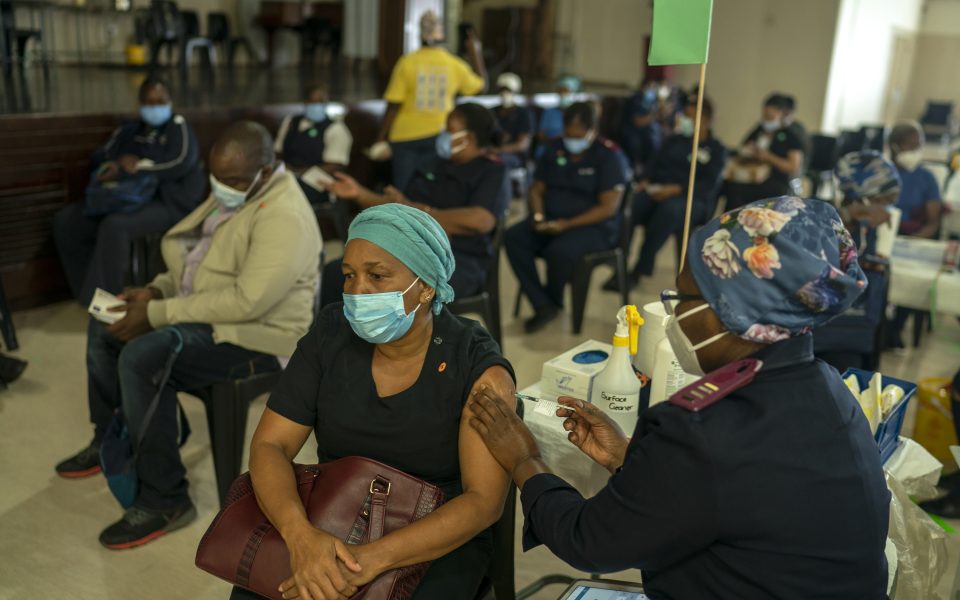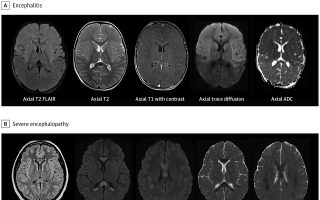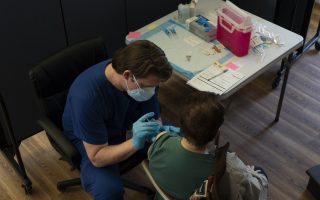‘We were flying blind’: A doctor’s account of a woman’s J&J vaccine-related blood clot case

An 18-year-old woman was stricken with severe headaches, vomiting, seizures, confusion and weakness in one arm early this month, strokelike symptoms that doctors at a Nevada hospital were shocked to see in someone so young.
Scans found several large blood clots blocking veins that drain blood from the brain, a condition that can disable or kill a patient.
Doctors performed a procedure to suction huge clots from her brain, only to find that new ones had formed.
The patient is one of six women ages 18 to 48 who developed clots in the brain within two weeks of receiving the Johnson & Johnson coronavirus vaccine. One died, and their devastating cases led US health officials to recommend Tuesday that use of the vaccine be paused.
Two more cases have been added since then: one involving a man who was vaccinated during the company’s clinical trials and another involving a woman who received the vaccine after it had been authorized for general use.
As in several of the original cases, the young woman in Nevada was initially treated with heparin, a standard blood-thinner that experts have since learned may actually worsen the rare clotting disorder that has affected small numbers of people who received the Johnson & Johnson or AstraZeneca vaccines in several countries. But until the last few weeks, doctors around the world had little information about the condition, and the doctors in Nevada did not recognize it immediately.
“We were flying blind, based on reports from Europe and the UK hematological society,” said Dr. Brian Lipman, an infectious-disease specialist who helped care for the Nevada patient at Dignity Health St. Rose Dominican Hospital, Siena Campus, in Henderson.
The US decision to call for suspension of the use of the vaccine was intended to give officials time to learn more about the rare disorder causing the clots, to assess whether it is linked to the vaccine and to inform doctors and patients about how to recognize symptoms and treat the condition.
The pause may last until at least next Friday, when expert advisers to the Centers for Disease Control and Prevention are scheduled to meet to review the data and decide whether to resume using the vaccine. Dr. Rochelle Walensky, the director of the CDC, and other top US health officials sought Friday to reassure the public that the pause, now extended more than a week, was a reasonable safeguard to assess risk. They also emphasized that overall, the Johnson & Johnson vaccine and the other vaccines in use in the United States were safe, given how many millions of Americans had gotten their shots without concern.
But with the world staggered by a relentless epidemic, even temporarily stopping the use of a highly effective vaccine, which many countries had planned to deploy, is a fraught decision. Public health experts fear that the move sends a message that will erode trust globally even if the vaccine is reinstated and that huge numbers of people who could have been immunized will die needlessly from COVID-19 because they or their governments rejected the company’s vaccine.
The United States, where Johnson & Johnson provided only about 5% of the COVID vaccine supply, can afford the suspension: It has plenty of other vaccine doses from Moderna and Pfizer-BioNTech to fill the gap. Other countries do not. And many nations have also stopped or limited the use of another effective vaccine, the one made by AstraZeneca, because it, too, has been linked to a similar rare clotting disorder.
About 7.4 million Americans have received the Johnson & Johnson vaccine, and so far, only eight cases of the clotting problem have been reported, seven of them in women. In Europe, Britain, and three other countries, 222 cases have been reported, mostly in women under 60 — of 34 million people who have received the AstraZeneca vaccine. Several countries have now limited its use to older adults because so many cases have involved younger people.
Researchers suspect that in these rare cases, the vaccine causes an intense reaction by the patient’s immune system, which churns out antibodies that activate platelets, a blood component needed for clotting. An unusual syndrome results, with extensive clotting that leaves the patient with low platelet levels and a tendency to bleed at the same time. Why this occurs in some people, many of them younger women, is not known, and experts say that they have so far been unable to identify traits or underlying conditions that may make some people susceptible.
In a statement issued Wednesday, Johnson & Johnson said: “The safety and well-being of the people who use our products is our number one priority, and we strongly support awareness of the signs and symptoms of this extremely rare event to ensure the correct diagnosis, appropriate treatment and expedited reporting by health care professionals. We continue to believe in the positive benefit-risk profile of our vaccine.”
The company also said, in a letter published Friday in The New England Journal of Medicine, that no causal link had been established between its vaccine and the clotting disorder.
To some critics, it makes no sense to hobble a global vaccination campaign during a pandemic just because of a few cases of a rare disorder.
But while rare side effects may be tolerated as the price we must pay for some drugs or vaccines, even the rarest ones are difficult to accept if they are severe and unpredictable — like blood clots in the brain, especially in young, healthy people.
“This is a devastating complication,” Dr. Anthony Fauci, the chief medical adviser for the pandemic in the Biden administration, said in an interview.
He added: “One woman died, three are in the hospital, one in intensive care. Even though the numbers are small, it is a devastating complication, so I believe — I didn’t make the decision — I believe their rationale, at least from what they communicated to me, is that they wanted to call a quick pause to see, to alert people. Sometimes this starts with minor symptoms, like a little abdominal discomfort, and then all of a sudden they wind up having a stroke.”
He also said, “Maybe there are a lot more people out there we’re not noticing, because of the spectrum of the disease.”
Informing doctors and the public of the symptoms — severe headaches, shortness of breath, leg or abdominal pain — could help identify more cases.
Another reason for the pause, Fauci said, is to let doctors know that the drug heparin, a standard treatment for blood clots, should not be given to these patients, “because heparin in this circumstance can make things worse.”
It is not known whether the heparin initially given to some of the patients exacerbated their condition.
Experts are recommending the use of other blood thinners, which patients urgently need, because their blood clots keep growing, and new ones keep forming. Doctors in Europe who treated recipients of the AstraZeneca vaccine who had a similar condition said it could worsen rapidly.
“The real issue is how long they take to make up their mind about what they’re going to do,” Fauci said of the CDC’s advisory panel. “The rest of the world is watching this, and J&J is hopefully going to be an important part of the worldwide response, as is AstraZeneca.” He added, “You don’t want to rush them, but I hope they make up their minds in a reasonable amount of time.”
Another of the first six patients with the clotting condition was a healthy 48-year-old woman who went to an emergency room in Nebraska because she had felt ill with abdominal pain for three days. Her case was described in a letter to the editor of The New England Journal of Medicine published Wednesday. Her platelet count was low, and other blood tests were also abnormal. A CT scan found extensive blood clots in veins in her abdomen. She began having headaches, and another scan found clots in her brain.
She was given heparin. More clots developed, and she had a hemorrhagic stroke.
Doctors then learned that she had received the Johnson & Johnson vaccine two weeks before. They stopped the heparin and gave her a different blood thinner, along with intravenous immune globulin, a treatment also recommended for the clotting disorder. Her platelet count increased, but, the doctors wrote, “The patient remained critically ill at the time of this report.”
The young woman in Nevada was fighting for her life and had to be placed on a ventilator, according to Lipman. He said he was speaking independently and not as a representative of the hospital.
The patient’s family declined a request for an interview.
Lipman said that as the team had studied her blood samples, the pieces began to fall into place, and they realized that she appeared to have the same problem that they knew had been occurring in Britain and Europe after patients received the AstraZeneca vaccine, mostly in young women. They switched from heparin to another blood thinner and began following guidance provided by doctors in Britain who had treated AstraZeneca recipients with a similar disorder.
Hoping for more information about the condition and any possible connection to the Johnson & Johnson vaccine, Lipman called an emergency number at the Food and Drug Administration. It was a weekend, and he said the person who answered told him that no one was available to help and that the line had to be kept open for emergencies.
“I thought this was an emergency,” Lipman said. “She hung up on me.”
He called back, to ask how to reach Janssen, which makes the Johnson & Johnson vaccine. That information was not available, and he said the person who answered had also told him that the FDA could not provide advice on patient care.
An FDA spokesperson, Stephanie Caccomo, said in an email, “We’ll look into this further to ensure physicians calling FDA for assistance receive the help they are seeking.”
Lipman said that the pharmacist at his hospital had submitted a report online to the CDC in early April but that the agency had not contacted him to ask about the case until this week. The agency declined to comment on whether it had communicated with Lipman, a spokesperson, Kristen Nordlund, said by email.
At a meeting Wednesday of a CDC advisory panel, Johnson & Johnson and Dr. Tom Shimabukuro, a safety expert at the agency, both presented data about the young woman in Nevada. After the meeting, Nevada officials issued a statement saying the meeting was the first time they had learned of a case in their state — they had previously told the public that no cases had been reported — and they were asking “federal partners” why the state had not been informed.
At the Nevada hospital, an interventional radiologist passed a tube through blood vessels and on into the young woman’s brain and used a device to suction out the blood clots. More clots formed later, and he performed the procedure again.
But the condition causes more than clots: The patient, like others, also had a brain hemorrhage.
She was transferred to a larger hospital, where she is still on a ventilator, Lipman said. Her prognosis is uncertain, he said, adding, “Her life, not just her life, her entire family’s life, has been transformed.”
[The New York Times]






